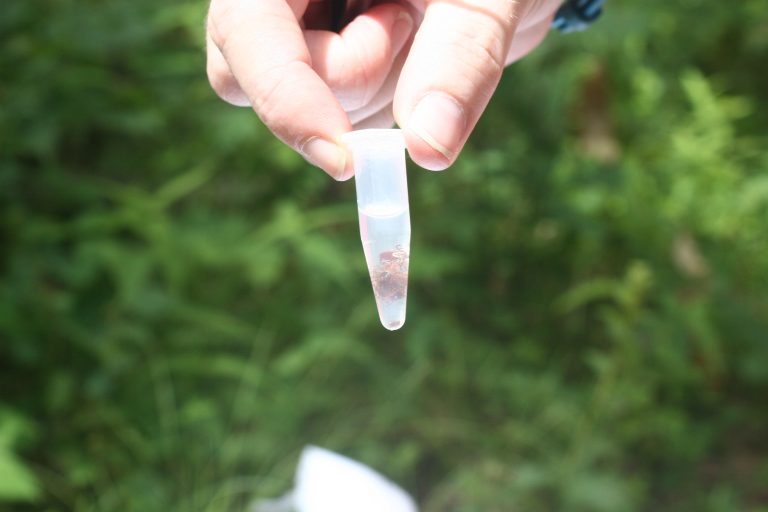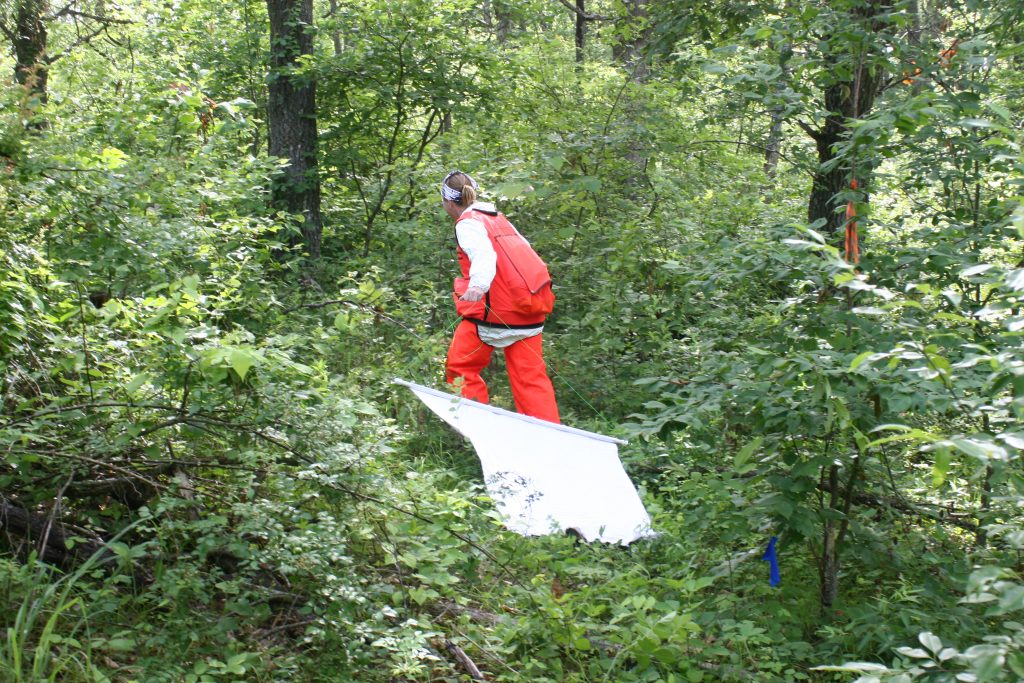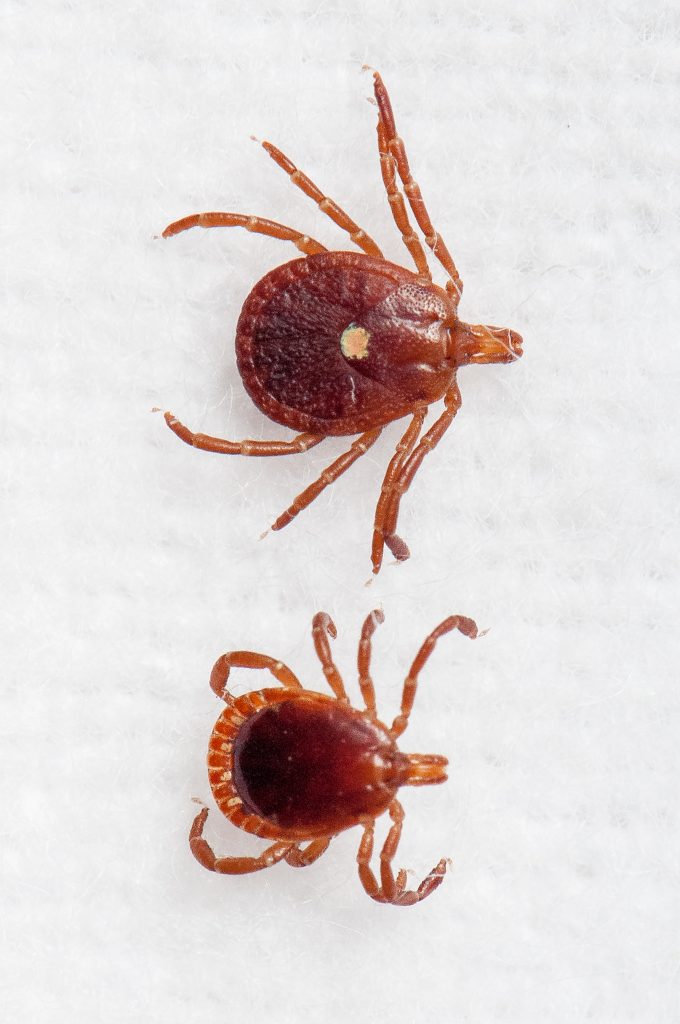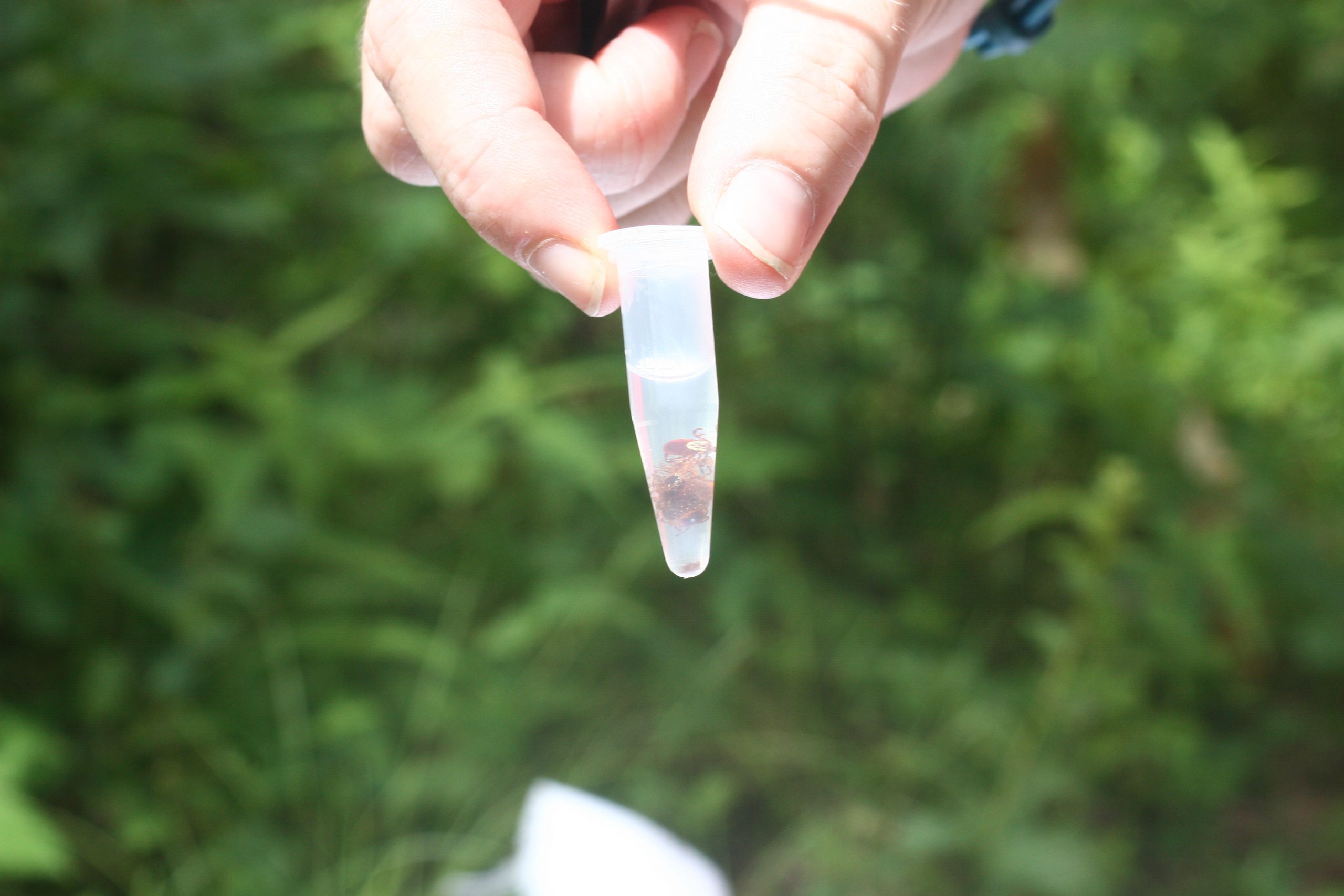Tick-borne diseases are on the rise. How can the public manage the problem?
Posted: July 15, 2020
This story is from the 2019-20 issue of Spark magazine.
By Katie Hubbard
Every month from April to September, Deborah Hudman, MS, suits up in Tyvek coveralls, chaps, and a vest full of supplies to collect ticks. She hikes through the public fields and forests of northeast Missouri to visit a dozen collection sites. Her research began with trying to understand the health risks associated with ticks in the area. Today, her research has expanded to include land management practices that best control tick populations and reduce risks of disease for those who work and play outdoors.
Hudman follows a methodical process at each site. At the base of a nearby tree, she locates a Kestrel meter, which records weather conditions every hour. She downloads data from the meter, including temperature, dew point, relative humidity, and heat stress index. Using weather meters at each site, near tick habitat, provides accurate data about the conditions that affect ticks at those specific coordinates.
At each site, she surveys three transects. She begins by unrolling a white felt flag and dragging it along the ground for 100 meters. Her method is slow. Because ticks are attracted to carbon dioxide, she uses herself as bait. She stops every few meters along each transect to pull ticks off the flag – and her suit. She places them in vials filled with ethanol, which preserves them until she can complete her analysis. Once she reaches the end of a transect, she rolls up her flag and heads to the next one.

Tick collection can be hot and uncomfortable work, but each month, she trudges on. A senior research associate in ATSU-KCOM’s Microbiology & Immunology department, Hudman began researching ticks in 2014. Since then, she has collected more than 87,000 ticks in northeast Missouri. The three species she has found are the lone star tick, American dog tick, and blacklegged tick. Lone star ticks are by far the most common species – representing nearly 90 percent of all ticks collected. American dog ticks are the second most common species, with blacklegged ticks found in very low numbers.
Initially, Hudman collected approximately 15,000 ticks from four areas in northeast Missouri: Big Creek, Sugar Creek, Montgomery Woods, and Shoemaker Conservation Areas. Using polymerase chain reaction assays, she found the presence of pathogens Ehrlichia chaffeensis and Ehrlichia ewingii, which cause ehrlichiosis in humans, and putative agents Borrelia lonestari, Rickettsia amblyommatis, and Rickettsia montanensis, which are suspected to be involved with southern tick-associated rash illness.
In 2015, she collected an additional 15,000 ticks from the same four conservation areas and tested for infection rates. According to her data, one in four adult ticks carries Ehrlichia species. This significant, yet unsettling result revealed the prevalence of pathogens in the region. In addition, she discovered the quantity of ticks collected from Big Creek and Sugar Creek was nearly half the number collected from Montgomery Woods and Shoemaker.
Montgomery Woods and Shoemaker are unmanaged conservation areas, while Big Creek and Sugar Creek are managed areas. The latter use land management techniques, such as disking, food plots, thinning and removing tree stands, and prescribed burning. Prescribed burns are fires set intentionally by a team of experts under certain weather conditions to restore health to ecosystems and control invasive plants.
With the high prevalence of pathogens in ticks, Hudman’s next step was to quantify the prevalence of residents acquiring tick-borne diseases and seeking medical treatment. Because symptoms of infected tick bites resemble those of the flu, cases are often untreated or misdiagnosed.
In 2017, she surveyed people who work outdoors, such as farmers and employees of the Missouri Department of Conservation (MDC) and U.S. Department of Agriculture. She found 38 percent of those surveyed were having flulike symptoms after a tick bite. In addition, 17 percent of people surveyed were removing 11 or more attached ticks per year, and 44 percent of healthcare providers surveyed were treating 11 or more patients per year for tick-borne diseases. According to the Missouri Department of Health and Senior Services, the only confirmed cases of tick-borne diseases from 2013-17 were for ehrlichiosis.
“Ehrlichiosis becomes life threatening for the elderly, very young, and immunocompromised,” Hudman says. “As we age, we need to be more careful with flu-like symptoms in the summer.”

Based on her 2015 data, Hudman added a twist to her tick research to gain a better understanding of how land management techniques affect tick populations. Specifically, she chose to focus on prescribed burning. She says many studies have evaluated prescribed burning as a mechanism for tick population control, but these studies have conflicting results depending on location, climatic conditions, frequency of burns, and size of plots burned.
“Prescribed burning is a promising strategy,” Hudman says. “It can be applied to large tracts of land without interfering with other land uses like cattle grazing, timber production, natural community restoration, and recreational hunting.”
In spring 2018, Hudman began a three-year study, in partnership with MDC, to collect tick species at Union Ridge Conservation Area. Hudman’s collection sites at Union Ridge are being rotated for prescribed burns by MDC, which will help her determine the effectiveness of prescribed burning in a controlled manner. Her continued collection and analysis will provide a more accurate assessment of the effects of prescribed burns on tick numbers and the pathogens they carry.
Ultimately, Hudman hopes her research will increase awareness of tick-borne disease in the medical community. As long as the antibiotic doxycycline remains effective, she says it is a very good way to treat tick-borne infections. She notes the best way to reduce risk of disease, of course, is to prevent tick bites altogether.
